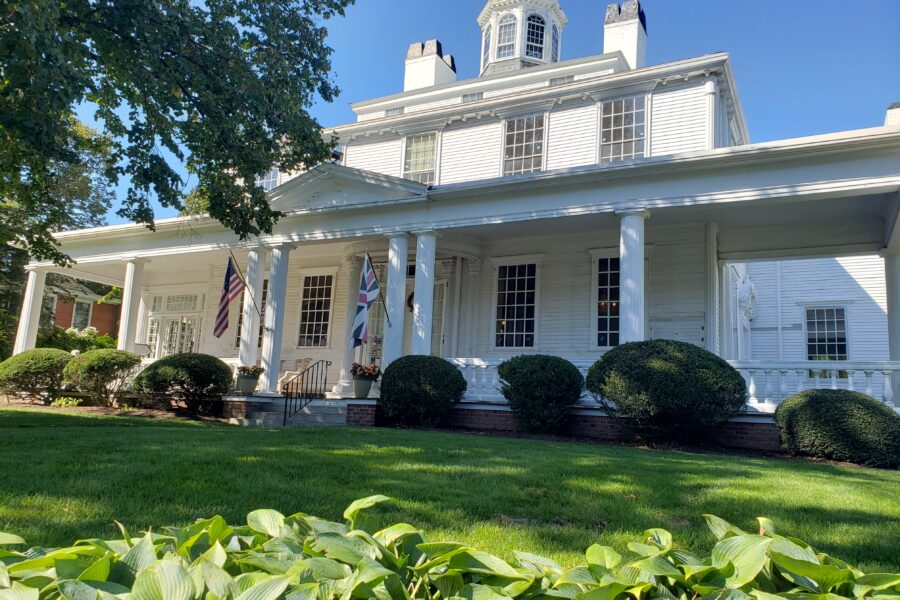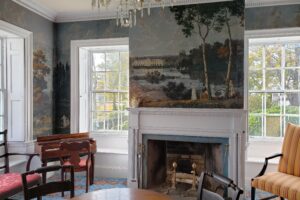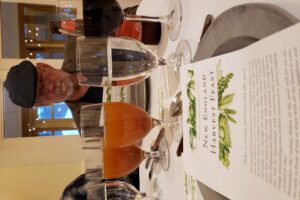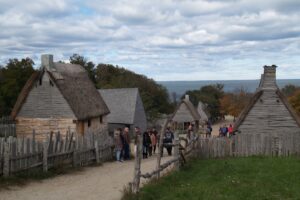Morning
Working my way into being totally present, I slowly sip hot coffee. Michael appears at my elbow and tells me, “I’m going for a walk.” He has way too much energy! I continue my morning ritual, blogging, dressing slowly, anticipating the day ahead. Shopping with Lisa. Lunch. A historic lecture. Dinner with Lisa’s friends.
Then I let the day unfold.
The first thing I do is apologize. “Lisa, I am so sorry. I’m still on CST. It’s an hour later than I thought — there is no time to shop!”
So instead, we rearrange furniture, just to see if some beautiful wing back chairs she is eyeing in a store downtown will work. She thinks they will. A purchase is on the menu for later today.
We chat while waiting for Michael to reappear at 11:15. There is no rest for the truly energetic it seems. When he walks through the door we let him know it is time for lunch at the harbor and we need to leave. Now.
Exploring
Michael retraces his earlier steps as Lisa gives us a tour on the way to her restaurant of choice for the day. Better than any tour guide she fills us with trivia and interesting tales as we make the short trip toward Cape Cod Bay. “This is the only house that was ever deemed haunted in a court of law,” she tells us, and then goes on to tell the whole story.

After passing the statue of Massasoit Sachem the leader of the Wampanoags who lived on this land long before the pilgrims arrived, we arrive at a series of steps going down to the harbor. Many many many steps going down! The first thing that occurs to me is not how beautiful the view of the harbor is from here, but—we’re going to have to climb back up to the top of the hill!

We stop by a monument to honor the Pilgrims on the Mayflower who died in Plymouth, and Lisa points to the name Mary Allerton, wife of Isaac Allerton; her long long ago ancestor. The ancestor that brought her to this town and the house she now owns because of his story and her involvement in the The General Society of Mayflower Descendants, and her love of history.

Isaac Allerton
And since Isaac Allerton seems to be at the crux of why the three of us stand here together, I am curious to know more. I learn that Isaac was married three times, the first wife was Mary who came with him on the Mayflower in 1620 as well as their three children, one son and two daughters. At the time of the voyage Isaac was approximately 33 years old, Mary was 30, Bartholomew, the son, was approximately 8; Remember, the oldest daughter was age 5; and Mary was age 4.

Mary, his wife, was pregnant during the ocean voyage and gave birth to a stillborn baby in Plymouth Harbor. She lived through the childbirth, but died in February 1621, during the first tortuous winter. Isaac and all three children survived. Isaac remarried a woman named Fear, daughter of William Brewster, in 1622 and had another daughter, Sarah, and a son, Isaac. His third marriage did not produce any children and he died at approximately 71 years of age.
I also learn Isaac was a man of substance, being elected assistant to Governor Bradford in 1621, continuing in that capacity well into the 1630s. He was sent to handle most of the buyout negotiations with the London investors that commenced in 1627, and continued through the early 1630s. Subsequently, he became an active merchant trader, engaging in transactions and trade with many neighboring colonies including the Dutch at New Netherlands; New Sweden; Virginia; Massachusetts Bay; and Barbados.
One thing I’ll always remember are the names Remember and Fear. And I thought naming your child Apple was strange.
Musings
My wee little mind tries to absorb all of these facts and I worry constantly about all I do not know and feel I should. The arrival of the Pilgrims on the shores of Massachusetts was a bare footnote in my long ago study of American History. As a child, Pilgrims and the Mayflower always meant going to Grandma’s house, turkey, dressing (which I hated back then—I saw that it came out of the turkey and I didn’t trust it at all), too many vegetables, pink tapioca, pies, cakes and a ride on the tractor with my uncle after he took us down to the pens to show us the squealing baby pigs. I have always liked Thanksgiving.
Isaac’s Restaurant
When I hear there is a restaurant named after Isaac Allerton, the first words out of my mouth are, “Well then, that is definitely where we need to eat.” I backtrack as quickly as I can, forgetting I am probably infringing on Lisa’s plans.


But we eat at Isaac’s anyway. It is a short walk down the street and up a flight of stairs with a wall of windows overlooking the bay. The crab cakes are delicious and I feel virtuous eating seafood, however I do relish every drop of sauce that accompanies them, and they are fried, as well as a few fried potatoes I can’t resist, so I guess my virtue is somewhat in question.

The Top of Plymouth
Looking at the clock, we realize we must hurry if we want to be on time for the archaeological lecture that is to start on Burial Hill.
Instead of retracing our steps and climbing the multilevel stairs, we walk uphill via the street. When we get to Main things level off till we turn right and begin another hike uphill on another street. Reaching the cemetery, I think, at last! But, once again there are steps leading up. A lot of steps. I don’t count the number. When we finally reach the top we have climbed up the equivalent of a 16 story building, or 165 feet from the harbor where we started. And our pace was not slow! I begin to wonder if I will get in a huge amount of trouble by leaning against one of the many tombstones. I really want to, but try very hard not to.

Burial Hill
On the National Register of Historic Places, the hill where we stand has been used for burials by Plymouth residents since the 1620s, and the Pilgrims built their first fort/meeting house here. I am a tiny bit disappointed that I learn more about the how than I do about the who, because it is the who that interests me most. I always wanted to be an archaeologist and go on a dig, unearthing the past, but now I am made to wonder at this dream of mine.



First Parish Church in Plymouth
It is a slippery slope we tread, because of the steepness of the hill and because of the numerous dried leaves that have fallen from the trees. Always a klutz, I try to find the path of least — or perhaps most — resistance on the way down. I notice I am not the only one that has a problem traversing the terrain. At the bottom of the hill, we stop to speak with Lisa’s friend Lea. A fellow Mayflower descendant who moved here from Louisiana.
Lea asks if we would like to see the interior of the First Parish Church in Plymouth. It is a historic Unitarian Universalist church at the base of Burial Hill on the town square off Leyden Street and is the site where the first church was erected by the Pilgrims in 1620. The current building was constructed in 1899, is in desperate need of repairs — currently there is a large red shroud covering the facade while work takes place on the exterior — and is open for a little while this afternoon. We jump at the chance.

The Church
This church is beautiful! It is truly elegant with its clean lines, and intricate carvings. Having gorgeous stained glass windows, some designed by Tiffany Studios depicting the Pilgrims story, all over the place doesn’t hurt either.
The building is an example of a Romanesque Revival-style church. We learn the building retains its exterior character-defining features, including the prominent Norman-inspired tower and the recessed, round-arched entrance with layered molding; which of course we can’t see because of that exquisite red shroud that covers the ENTIRE EXTERIOR. I make a mental note to myself to look it up when we return to Lisa’s and see if I can find a photograph. There must be thousands on the Internet.

The design of the church, and many interior features, including the hand carved scalloped shells adorning each pew, were intended to establish it as a memorial church to the Pilgrims. It is also the fourth meetinghouse built for its congregation on this site.



I am beginning to feel very historical. Actually, I am feeling overwhelmed with history and historical facts. This seems to happen to me everywhere we go. I should be used to my lack of historical knowledge by now. Perhaps I should have been a historian. It is all about the who.
In between our tours and dinner, Lisa and I go shopping. She purchases her chairs and arranges delivery, while I, I fall in love with a Scotsman, and do nothing about it. But think.

Dinner at Leena’s Kitchen
Dinner is a true break from history. We dine in Leena’s Kitchen. A pretty much new, clean, crisp, pristine restaurant, filled with patrons at 5:30 pm. Lisa’s friends swear by it. I’m looking forward to doing the same. I’m told the carpaccio is good, and the pasta carbonara is as good as if you were in Rome. I’m sold. And then because I am who I am, I don’t order it, but Michael does. I never should have said, “I’m looking for something light,” out loud. In all honesty, I was thinking salmon, but I order a seemingly new age pasta because the waitress sells and sells and sells till Michael pretty much says, “She’s sold!”
My response is—“I’m still not sure…”
The waitress begins selling again, so I say, “YES, that is what I’ll have.”

The beef carpaccio, tissue-paper thin with a major dose of fried capers, is great. I’m going to have to start using these as a garnish at home. They bring the humble caper, which I totally love, to a whole new level. I have a small bite of Lea’s gnocchi, and it is heaven. Michael’s carbonara is superb. My pasta wins the prize for the most beautiful presentation. Everything on the plate is good, but not Italian comfort food. I’m never going to think out loud again.


I order dessert for Michael and me to share, because I can’t possibly be the only one that refrains from temptation. The tiny lemon tart is perfect. The crust is deceiving. It is light and flaky and dissolves the minute it hits my tongue.

We climb our last flight of stairs for the day and fall into bed. I need to remember to tell Lisa, Michael and I have a rule – one thing a day.
Did you know?
According to the General Society of Mayflower Descendants, there are an estimated 10 million living Americans and as many as 35 million people worldwide descended from the Pilgrims. Possibly you may be one of them. I don’t have a chance, I am barely third generation American, able to trace my roots back to the ship my ancestors came in on on Texas Gulf Coast.
But if you are interested to see if you qualify, this link will tell you how to get started.









Leave a Reply
Your email is safe with us.